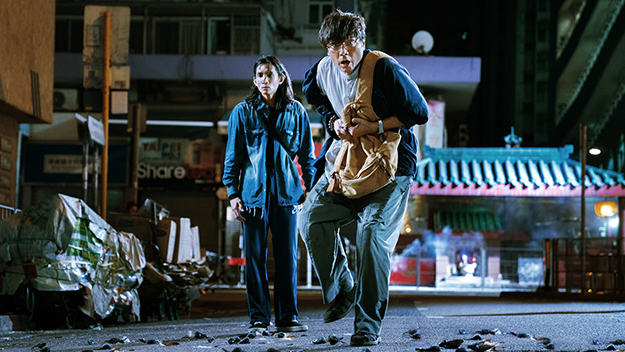Double Impact: Soi Cheang’s Limbo and Mad Fate
This article appeared in the January 12, 2024 edition of The Film Comment Letter, our free weekly newsletter featuring original film criticism and writing. Sign up for the Letter here.

Mad Fate (Soi Cheang, 2023)
Over the course of the past two decades, Hong Kong action director Soi Cheang has built an oeuvre that stands shoulder to shoulder with the finest work of the late-’80s/early-’90s “golden age” of Hong Kong cinema—even though he emerged in the wake of the 1997 handover that decimated the former colony’s film industry. His closest analogue is Johnnie To, whose movies similarly straddle art-house and genre-film paradigms. But while the relentlessly productive To seems to spin entertaining and substantial works out of thin air, Cheang creates at a more deliberate pace, typically releasing a film every three or four years (at least when he isn’t directing for hire on the CGI-heavy Monkey King series) and engaging forcefully with the cruelty—and resilience—of modern life.
Following Cheang’s steady output of horror titles in the early 2000s, Accident (2009) marked the flowering of his unique vision. That film was also his first collaboration with To’s production company, Milkyway Image, and its crew of consummate craftspeople. Accident follows a hit man caught in his very own version of The Conversation (1974). An orchestrator of deaths dressed up as freak occurrences, our antihero (Louis Koo) becomes convinced that his team is being targeted, dissolving his choreographed lifestyle into a haze of paranoia. The subversive sensibility and thematic preoccupations of Accident—which include grievous bodily harm, the ugliness of humanity, and surveillance—course through the four non–Monkey King features Cheang has made since then. Motorway (2012), a film about police pursuit drivers, is notable for how relatively slow most of the chase scenes are, its thrills more menacing than high-octane. The most unconventional of all of Cheang’s films (and the first to receive significant recognition in America) is a loose franchise entry, SPL II: A Time for Consequences (2015)—a blistering martial-arts saga that takes its organ-trafficking setup as a visceral metaphor for the damage that must be dealt and suffered in order to right the balance of the world.
Cheang’s two latest features, Limbo (2021) and Mad Fate (2023), were not conceived as a pair, but their joint theatrical release in the U.S. last year highlights their commonalities: both star Hong Kong genre stalwart Gordon Lam and employ Milkyway crew members, including cinematographer Cheng Siu-keung, editor David Richardson, and screenwriter Au Kin-yee. A police procedural shot in luminous black and white, Limbo tracks the hunt for a serial killer who fixates on severing his victims’ left hands. If its low-tech, shoe-leather portrayal of detective work belongs to a familiar tradition of investigation movies, the setting is singularly specific: much of the film unfolds across the mazelike alleyways of Hong Kong, where the main investigators—Lam as Cham, a forlorn older cop; Mason Lee as Will, a young stickler for protocol—endlessly sift through mountainous garbage heaps in search of corpses, body parts, and mislaid guns.
Only a few other characters stand out, most of all Wong To (Liu Cya), a young woman just released from prison for running over Cham’s wife, who is forced to inform on every criminal in her network to aid the cop’s pursuit of the killer. That twisted form of penance typifies the emotional undertow of this unrelentingly bleak film, locking hunter and target into a spiral of degradation under a deluge of near-constant rain. Limbo isn’t simply a drudge through the horrors of urban existence, though. The consistent inventiveness of Cheang’s filmmaking is exhilarating: a three-pronged chase scene toggles among multiple perspectives in a single location, balancing contrasting levels of urgency and motion. These vivid, stylish images only make it harder to look away from the exploitative underworld.
This dismal worldview is leavened, if not entirely absent, in Mad Fate. Gone is Lam’s moody, abusive cop; instead, he plays a vehemently devout astrologer, obsessed with changing the destinies of the doomed via spiritual means. Seemingly by chance, one such soul wanders into his path: a young man (Lokman Yeung) with a lifelong fixation on killing, whose victims have comprised only stray cats thus far. There are secondary plots, too—one revolves around an unassuming man who is compelled to murder sex workers when it rains, and another around the police officer chasing after both of these twisted men—but the film centers on the dynamic between the fortune teller and the young man. Mad Fate is a smaller, more blackly comic affair than Cheang’s previous films, though its concerns feel just as grand thanks to the cosmic convictions of its characters. While the physical and emotional brutality of Limbo immerse the viewer in urban grime, Mad Fate’s bright neons and dramatic CGI clouds are overtly unreal, as inexplicable and strange as the sudden downpours and mudslides that constantly impede the characters’ progress. By their respective ends, the astrologer and the cat-killer embrace the suffering and insanity around them. As both Mad Fate and Limbo demonstrate, Cheang’s great gift, in addition to his immense technical prowess, is his ability to channel the extreme capacity for horror inherent to contemporary urban life into gripping tales of destruction and redemption.
Ryan Swen is a freelance film critic and a member of the Los Angeles Film Critics Association.







